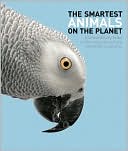Smartest Animals on the Planet: Extraordinary Tales of the Natural World's Cleverest Creatures
Search in google:
How animals communicate and learn -- sometimes better than humans do, actually.This fascinating book, written by a world authority on animal intelligence, brings together the cumulative research on the comparative intelligence levels of nonhuman "smart" species. Sally Boysen reveals how these intelligent animals communicate, learn behavior, show feelings and emotions and, for some species, how they use tools, count and sometimes pick up a foreign language. Fully illustrated with photographs and step-by-step graphics, the book draws on data from historical and current experiments and observations to examine intelligence in the great apes (gorillas, chimpanzees and orangutans) and in a surprising list of other species, including sea otters, eagles, elephants, dolphins, birds, bees, beetles, rats, raccoons and parrots.The book's chapters are:Comparing Animal Skills and IntelligenceAnimal Tool UseCommunication in AnimalsImitation and Social LearningSocial Cognition and EmotionSelf-recognition and AwarenessNumerical Abilities in AnimalsAnimals and Human Nonverbal Language.The Smartest Animals on the Planet is a beautiful, authoritative and up-to-date presentation on the remarkable intelligence of the animal kingdom. Publishers Weekly The first studies of animal intelligence focused on chimps, gorillas and orangutans, simply because humans assumed intelligence was the province of higher primates; other species, it was thought, acted through instinct. Then twentieth century field biologists began reporting observations of problem-solving in many other species: bees dancing to convey pollen locations, whales using complex sounds to communicate across entire ocean basins, crows using sticks to pull grubs from tree bark, salamanders differentiating between smaller and larger food sources. Each animal is placed into one of seven categories-tool making and use, communication, learned social behaviors, individual self-awareness, numerical ability, language learning and group cooperation/mutual protection-though they clearly overlap, showing how animals place on different axes of intelligence (a dolphin exhibits tool use and learned culture skills when showing her pup how to fish with a sponge). Vibrant color photographs and diagrams illustrate species and behavioral sequences like the different facial cues of baboons (the "kings of expression"). Clearly-written text is aimed primarily at adults, but suitable for middle school and advanced elementary school students (with help from the included glossary). An ideal family gift, this should also find use in the classroom. Copyright © Reed Business Information, a division of Reed Elsevier Inc. All rights reserved.
Foreword About this book Introduction Chapter One: Using ToolsWoodpecker finches probe with sticks New Caledonian crows hook a treat Captive crows show talent for tool use Sea otters hammer their way to a meal Sea sponges provide padded protection Naked mole-rats protect their assests Why elephants use switches The wild chimp's toolkit Use of spears by wild chimpanzees Sumatrans get to grips with tools Wild gorillas stun researchers Wild capuchins adapt tool use to suit their environment Innovations with tools in captive capuchins Tool use in captive chimps Chapter Two: Communication Dance language of honeybees Ground squirrels look out for their own Wild vervet monkey "smart" alarms Baboons: kings of expression Diana monkeys spread the news Wild chimpazees: masters of communication Signature whistles in dolphins Whales can really carry a tune Can elephants hear through their feet? Chapter Three: Imitation and Social Learning Monkey see, monkey do? Jungle copy cats Birdbrained is best The great ape debate Ape culture? Chapter Four: Mirror Self-Recognition Chimps use mirrors like we do - to see how they look Dolphins give themselves admiring glancesIt's rude to stare - gorillas don't give mirrors a second glance Elephants get the idea - with a very big mirror Chapter Five: Numerical Abilities The case of "Clever Hans" You can count on an ant to find its way home Lions show roar talent Birds: the number crunchers Rats that can count Salamanders prefer more Young chimps learn to count Chapter Six: Animal Language Studies Can you really teach a chimp to speak?How a chimp learned sign languageChimps and humans: do two great brains think alike?Ask a dolphin and you'll get the right answerKoko, the only gorillas to learn sign languageIs he smart, or just parroting what he's heard?A young chimp keeps her answers in orderAn orangutan learns to signRocky, the sea lion with a logical approach Chapter Seven: Cooperation and Altruism"I'll scratch your back now, if you'll scratch my back later"Chimps "kiss and make up" after a fightYawn and the world yawns with you - empathetic responsesA dog's dinner is a shared affairWorking together - is it teamwork or just a bunch of animals?Monkeys are quick to spot an unfair dealGlossary Index Credits








